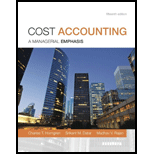
Cost Accounting: A Managerial Emphasis, 15th Edition
15th Edition
ISBN: 9780133803815
Author: Charles T. Horngren, Srikant M. Datar, Madhav V. Rajan
Publisher: PEARSON
expand_more
expand_more
format_list_bulleted
Textbook Question
Chapter 12, Problem 12.34P
Balanced scorecard. Following is a random-order listing of perspectives, strategic objectives, and performance measures for the balanced scorecard.
- Perspectives
- Internal business process
- Customer
- Learning and growth
- Financial
- Strategic Objectives
- Acquire new customers
- Increase shareholder value
- Retain customers
- Improve manufacturing quality
- Develop profitable customers
- Increase proprietary products
- Increase information-system capabilities
- Enhance employee skills
- On-time delivery by suppliers
- Increase profit generated by each salesperson
- Introduce new products
- Minimize invoice-error rate
- Performance Measures
- Percentage of defective-product units
- Return on assets
- Number of patents
- Employee turnover rate
- Net income
- Customer profitability
- Percentage of processes with real-time feedback
- Return on sales
- Average job-related training-hours per employee
- Return on equity
- Percentage of on-time deliveries by suppliers
- Product cost per unit
- Profit per salesperson
- Percentage of error-free invoices
- Customer cost per unit
- Earnings per share
- Number of new customers
- Percentage of customers retained
For each perspective, select those strategic objectives from the list that best relate to it. For each strategic objective, select the most appropriate performance measure(s) from the list.
Expert Solution & Answer
Want to see the full answer?
Check out a sample textbook solution
Students have asked these similar questions
I am looking for the correct answer to this general accounting question with appropriate explanations.
Please explain the solution to this general accounting problem with accurate principles.
subject=general accounting
Chapter 12 Solutions
Cost Accounting: A Managerial Emphasis, 15th Edition
Ch. 12 - Define strategy.Ch. 12 - Describe the five key forces to consider when...Ch. 12 - Prob. 12.3QCh. 12 - What is a customer preference map, and why is it...Ch. 12 - Prob. 12.5QCh. 12 - What are four key perspectives in the balanced...Ch. 12 - What are the five types of conditions to consider...Ch. 12 - Describe three features of a good balanced...Ch. 12 - What are three important pitfalls to avoid when...Ch. 12 - Describe three key components in doing a strategic...
Ch. 12 - Why might an analyst incorporate the...Ch. 12 - How does an engineered cost differ from a...Ch. 12 - What is downsizing?Ch. 12 - What is a partial-productivity measure?Ch. 12 - Prob. 12.15QCh. 12 - Prob. 12.16ECh. 12 - Prob. 12.17ECh. 12 - Prob. 12.18ECh. 12 - Prob. 12.19ECh. 12 - Prob. 12.20ECh. 12 - Prob. 12.21ECh. 12 - Prob. 12.22ECh. 12 - Prob. 12.23ECh. 12 - Prob. 12.24ECh. 12 - Prob. 12.25ECh. 12 - Prob. 12.26ECh. 12 - Prob. 12.27ECh. 12 - Prob. 12.28ECh. 12 - Prob. 12.29ECh. 12 - Balanced scorecard and strategy. Scott Company...Ch. 12 - Prob. 12.31PCh. 12 - Prob. 12.32PCh. 12 - Prob. 12.33PCh. 12 - Balanced scorecard. Following is a random-order...Ch. 12 - Prob. 12.35PCh. 12 - Prob. 12.36PCh. 12 - Prob. 12.37PCh. 12 - Prob. 12.38PCh. 12 - Prob. 12.39PCh. 12 - Prob. 12.40PCh. 12 - Prob. 12.41P
Knowledge Booster
Learn more about
Need a deep-dive on the concept behind this application? Look no further. Learn more about this topic, accounting and related others by exploring similar questions and additional content below.Similar questions
- Can you help me solve this general accounting problem using the correct accounting process?arrow_forwardPlease help me solve this general accounting question using the right accounting principles.arrow_forwardPlease provide the answer to this general accounting question with proper steps.arrow_forward
- I need help with this general accounting question using the proper accounting approach.arrow_forwardI am trying to find the accurate solution to this general accounting problem with the correct explanation.arrow_forwardPlease provide the answer to this general accounting question with proper steps.arrow_forward
arrow_back_ios
SEE MORE QUESTIONS
arrow_forward_ios
Recommended textbooks for you
 Cornerstones of Cost Management (Cornerstones Ser...AccountingISBN:9781305970663Author:Don R. Hansen, Maryanne M. MowenPublisher:Cengage LearningPrinciples of Accounting Volume 2AccountingISBN:9781947172609Author:OpenStaxPublisher:OpenStax College
Cornerstones of Cost Management (Cornerstones Ser...AccountingISBN:9781305970663Author:Don R. Hansen, Maryanne M. MowenPublisher:Cengage LearningPrinciples of Accounting Volume 2AccountingISBN:9781947172609Author:OpenStaxPublisher:OpenStax College Principles of Cost AccountingAccountingISBN:9781305087408Author:Edward J. Vanderbeck, Maria R. MitchellPublisher:Cengage Learning
Principles of Cost AccountingAccountingISBN:9781305087408Author:Edward J. Vanderbeck, Maria R. MitchellPublisher:Cengage Learning Managerial AccountingAccountingISBN:9781337912020Author:Carl Warren, Ph.d. Cma William B. TaylerPublisher:South-Western College Pub
Managerial AccountingAccountingISBN:9781337912020Author:Carl Warren, Ph.d. Cma William B. TaylerPublisher:South-Western College Pub Financial And Managerial AccountingAccountingISBN:9781337902663Author:WARREN, Carl S.Publisher:Cengage Learning,
Financial And Managerial AccountingAccountingISBN:9781337902663Author:WARREN, Carl S.Publisher:Cengage Learning, Managerial Accounting: The Cornerstone of Busines...AccountingISBN:9781337115773Author:Maryanne M. Mowen, Don R. Hansen, Dan L. HeitgerPublisher:Cengage Learning
Managerial Accounting: The Cornerstone of Busines...AccountingISBN:9781337115773Author:Maryanne M. Mowen, Don R. Hansen, Dan L. HeitgerPublisher:Cengage Learning

Cornerstones of Cost Management (Cornerstones Ser...
Accounting
ISBN:9781305970663
Author:Don R. Hansen, Maryanne M. Mowen
Publisher:Cengage Learning

Principles of Accounting Volume 2
Accounting
ISBN:9781947172609
Author:OpenStax
Publisher:OpenStax College

Principles of Cost Accounting
Accounting
ISBN:9781305087408
Author:Edward J. Vanderbeck, Maria R. Mitchell
Publisher:Cengage Learning

Managerial Accounting
Accounting
ISBN:9781337912020
Author:Carl Warren, Ph.d. Cma William B. Tayler
Publisher:South-Western College Pub

Financial And Managerial Accounting
Accounting
ISBN:9781337902663
Author:WARREN, Carl S.
Publisher:Cengage Learning,

Managerial Accounting: The Cornerstone of Busines...
Accounting
ISBN:9781337115773
Author:Maryanne M. Mowen, Don R. Hansen, Dan L. Heitger
Publisher:Cengage Learning
Elements of cost | Direct and Indirect: Material, Labor, & Expenses; Author: Educationleaves;https://www.youtube.com/watch?v=UFBaj6AHjHQ;License: Standard youtube license